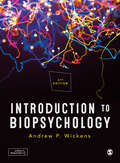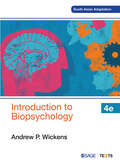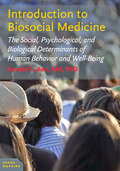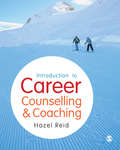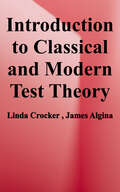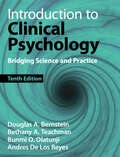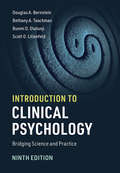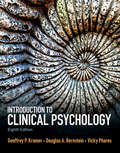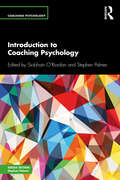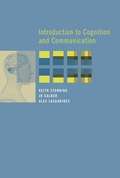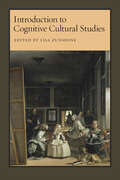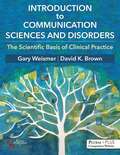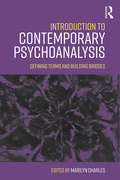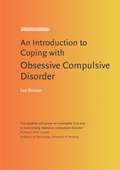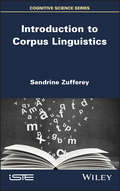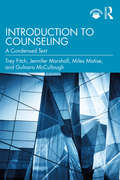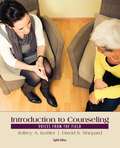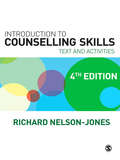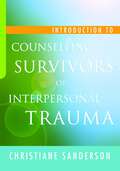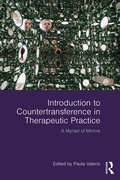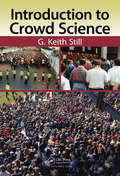- Table View
- List View
Introduction to Biopsychology
by Andrew P. WickensUnderstand the foundations of biological psychology and explore the stories behind important discoveries in the field. Everything you need to know about brain and behaviour – from sensory systems, eating disorders and sleep to drugs, language and memory. This fourth edition has been fully updated throughout, and includes new figures and diagrams, revised learning features, and clear explanations of over 330 key terms. Includes: The latest research on the neural basis of mental illness, degenerative diseases, and genetics Key Figure and Special Interest boxes spotlight interesting researchers, studies and discoveries of conditions End-of-chapter MCQs test understanding and support your preparation for assessments 250 full colour diagrams and figures illustrate the key concepts in each chapter Supported by online teaching and learning resources including drag and drop exercises for students, an instructor’s manual, testbank, and PowerPoint slides. Introduction to Biopsychology is essential reading for all Psychology students studying biological psychology.
Introduction to Biopsychology
by Andrew P. WickensBiological Psychology is one of the main subjects psychology students must study and universities must offer to have BPS accredited status in the UK. It is similarly an essential topic on Psychology degrees in Europe and Australia. The subject is often taught in the first year and can be challenging, as it demands an understanding of brain physiology and basic neuroscience, which is then applied to psychological topics such as emotions, senses, behaviours (eating, sleeping etc) and psychological disorders such as schizophrenia. Wickens is a well-known text in this field, formerly published by Pearson but not updated since 2009. It is praised for its historical context setting, a very important aspect for students wishing to attain BPS accreditation, and for its accessible whilst still scientifically rigorous writing style.
Introduction to Biosocial Medicine: The Social, Psychological, and Biological Determinants of Human Behavior and Well-Being
by Donald A. BarrUnderstanding human behavior is essential if medical students and doctors are to provide more effective health care.While 40 percent of premature deaths in the United States can be attributed to such dangerous behaviors as smoking, overeating, inactivity, and drug or alcohol use, medical education has generally failed to address how these behaviors are influenced by social forces. This new textbook from Dr. Donald A. Barr was designed in response to the growing recognition that physicians need to understand the biosocial sciences behind human behavior in order to be effective practitioners. Introduction to Biosocial Medicine explains the determinants of human behavior and the overwhelming impact of behavior on health. Drawing on both recent and historical research, the book combines the study of the biology of humans with the social and psychological aspects of human behavior. Dr. Barr, a sociologist as well as physician, illustrates how the biology of neurons, the intricacies of the human mind, and the power of broad social forces all influence individual perceptions and responses. Addressing the enormous potential of interventions from medical and public health professionals to alter these patterns of human behavior over time, Introduction to Biosocial Medicine brings necessary depth and perspective to medical training and education.
Introduction to Career Counselling & Coaching
by Hazel ReidA practical introduction for those training in the field of career development, career counselling and career coaching, this book will take your students through established and emerging theory and the different contexts in which career work takes place introducing the key skills, techniques and models they’ll need. Professional issues such as the use of digital technologies highlight the contemporary context of careers work and all of this is brought to life through engaging case studies and reflective questions, highlighting the practical applications of what is being learnt.
Introduction to Career Counselling and Coaching
by Hazel ReidA practical introduction for those training in the field of career development, career counselling and career coaching, this book will take your students through established and emerging theory and the different contexts in which career work takes place introducing the key skills, techniques and models they'll need. Professional issues such as the use of digital technologies highlight the contemporary context of careers work and all of this is brought to life through engaging case studies and reflective questions, highlighting the practical applications of what is being learnt.
Introduction to Classical and Modern Test Theory
by Linda Crocker James AlginaStudents of modern test theory must acquire a base of knowledge about classical psychometrics, but they must also be able to integrate new ideas into that framework of knowledge. <p><p>This text was written to help the reader attain these ends. The reader who hopes to find only a series of “cookbook” steps on how to carry out any specific process, uncluttered by technical discussion or statistical symbols, will be disappointed. <p><P>We recognize that “best” or “most recommended” procedures for any aspect of test development may change as new ideas and empirical findings are published. Thus it seems desirable for the students of test theory to acquire some practice in reading material that contains technical terms and symbols similar to those which will be encountered as they graduate from a textbook and begin to read the professional literature independently.
Introduction to Clinical Psychology
by Jeffrey Hecker Geoffrey ThorpeThis introductory textbook gives students an appreciation of the field of clinical psychology as an applied science by teaching them the history and future of the field as well as ethical dilemmas facing psychologists today. It is organized around four key themes: • Science: the text analyzes and critiques research and practice in clinical psychology from a scientific perspective. • Controversies: the text examines the conflict and controversies that continue to shape the discipline of Psychology. • Currency: the text surveys the field of contemporary clinical psychology. • Ethics: the text discusses ethical dilemmas faced by clinical psychologists in every chapter.
Introduction to Clinical Psychology: Bridging Science and Practice
by Douglas A. Bernstein Bethany A. Teachman Bunmi O. Olatunji Andres De Los ReyesFully updated and revised, the tenth edition of this bestselling textbook introduces clinical psychology as a bridge between science and practice. Featuring over 1000 new references, the revised text includes additional coverage of digital mental health, diversity, and identity, and the practice of evidence-based clinical science. Coverage of such topics as emerging models for clinical training and accreditation, new approaches to diagnosing and classifying mental illness, and changes in healthcare legislation ensure that students will understand the very latest trends in the subject. The pedagogical focus of previous editions is maintained. 'Thinking Scientifically' sections in each chapter break down how to evaluate conflicting findings and use them to draw conclusions, while clinical vignettes bring concepts and theories to life. 'In Review' tables at the end of each major section prompt students to review material and test their comprehension. The text is accompanied by a full suite of online teaching supports.
Introduction to Clinical Psychology: Bridging Science and Practice
by Bethany A. Teachman Douglas A. Bernstein Scott O. Lilienfeld Bunmi O. OlatunjiThoroughly updated and revised, the ninth edition of this bestselling textbook introduces students to clinical psychology as a bridge between science and practice. Extensive revisions since the previous edition have resulted in the most accessible, up-to-date and thematically integrated edition of Introduction to Clinical Psychology yet, while maintaining the authority and accessibility students and instructors have come to rely on. Updates include: three new co-authors who are internationally recognized scholar-practitioners; illustrations of how psychologists use evidence-based practices to help clients; the fictional 'Jackson family' case studies, providing vivid examples of a family confronting numerous mental health challenges; 'Thinking Scientifically' sections in each chapter, which break down how students can think critically with conflicting findings and use them to draw conclusions; 'In Review' tables at the end of each major section prompting students to review the material and test their comprehension; and an expanded image program, printed in color for the first time.
Introduction to Clinical Psychology: International Edition (Mysearchlab Series 15% Off Ser.)
by Douglas A. Bernstein Vicky Phares Geoffrey P. KramerDesigned to provide a thorough survey of the field, Introduction to Clinical Psychology, eighth edition, is accessible to advanced undergraduates as well as graduate students. This text presents a scholarly portrayal of the history, content, professional functions, and the future of clinical psychology. Extensive use of case material and real-world applications illustrates each theoretical approach. After reading this book, students will better understand clinical psychology as a field of professional practice and scientific research, and will be better able to apply theoretical concepts to real-world clinical cases.
Introduction to Coaching Psychology (Coaching Psychology)
by Siobhain O’RiordanThis collection featuring chapters by leading international practitioners will offer an introduction to coaching psychology for those new to it, including students, trainees, psychologists, and coaches. Introduction to Coaching Psychology covers key topics, including the background and development of coaching psychology, the coach-coachee relationship, coaching psychology approaches and models, and themes such as assessment, contracting, and the setup in coaching psychology practice. Applications in coaching psychology are considered, including a look at particular coaching psychology specialisms and interventions, as well as discussions about working in organisations, working with young people, and life and personal coaching. Professional practice issues, such as boundaries and best practice, and coaching and diversity, are also explored. Furthermore, a review of coaching psychology research is presented. The book also offers a rich collection of case studies to illustrate the practice of coaching psychology in a real-world setting and concludes with a consideration of the future of the field. This timely and accessible book will be essential reading for anyone new to the field, as well as coaches, psychologists, and counsellors interested in the theory, research, and practice of coaching psychology.
Introduction to Cognition and Communication
by Keith Stenning Alex Lascarides Jo CalderThis introduction to the interdisciplinary study of cognition takes the novel approach of bringing several disciplines to bear on the subject of communication. Using the perspectives of linguistics, logic, AI, philosophy, and psychology--the component fields of cognitive science--to explore topics in human communication in depth, the book shows readers and students from any background how these disciplines developed their distinctive views, and how those views interact. The book introduces some sample phenomena of human communication that illustrate the approach of cognitive science in understanding the mind, and then considers theoretical issues, including the relation of logic and computation and the concept of representation. It describes the development of a model of natural language and explores the link between an utterance and its meaning and how this can be described in a formal way on the basis of recent advances in AI research. It looks at communication employing graphical messages and the similarities and differences between language and diagrams. Finally, the book considers some general philosophical critiques of computational models of mind. The book can be used at a number of different levels. A glossary, suggestions for further reading, and a Web site with multiple-choice questions are provided for nonspecialist students; advanced students can supplement the material with readings that take the topics into greater depth.
Introduction to Cognitive Cultural Studies
by Lisa ZunshineDrawing on the explosion of academic and public interest in cognitive science in the past two decades, this volume features articles that combine literary and cultural analysis with insights from neuroscience, cognitive evolutionary psychology and anthropology, and cognitive linguistics. Lisa Zunshine’s introduction provides a broad overview of the field. The essays that follow are organized into four parts that explore developments in literary universals, cognitive historicism, cognitive narratology, and cognitive approaches in dialogue with other theoretical approaches, such as postcolonial studies, ecocriticism, aesthetics, and poststructuralism. Introduction to Cognitive Cultural Studies provides readers with grounding in several major areas of cognitive science, applies insights from cognitive science to cultural representations, and recognizes the cognitive approach’s commitment to seeking common ground with existing literary-theoretical paradigms. This book is ideal for graduate courses and seminars devoted to cognitive approaches to cultural studies and literary criticism.Contributors: Mary Thomas Crane, Nancy Easterlin, David Herman, Patrick Colm Hogan, Bruce McConachie, Alan Palmer, Alan Richardson, Ellen Spolsky, G. Gabrielle Starr, Blakey Vermeule, Lisa Zunshine
Introduction to Communication Sciences and Disorders: The Scientific Basis of Clinical Practice
by David K. Brown Gary G. WeismerIntroduction to Communication Sciences and Disorders: The Scientific Basis of Clinical Practice is designed for undergraduate students who are taking a first course in the discipline of Communication Sciences and Disorders (CSD). The textbook presents students with the range of communication impairments in society, the consequences of those impairments for the persons who have them as well as for their family members, and the treatments that are available to lessen or remediate the effects of the disorders. The text is organized into three sections on Language, Speech, and Hearing. Each chapter is concise and written to convey the core information for each topic. The material is presented in a way that maintains the interest of the student through expository clarity and brevity in a course that treats so many different facets of a complex discipline. The textbook also serves the needs of the instructor by organizing the material in a teachable way. Introduction to Communication Sciences and Disorders emphasizes the scientific basis of the field by presenting specific clinical examples to demonstrate the translation of laboratory science to clinical aspects of speech, language, and hearing disorders. Students will leave the course a good deal more knowledgeable and sensitive about what it means to be communicatively impaired in contemporary society.
Introduction to Computational Cultural Psychology
by Yair NeumanHuman psychology is deeply rooted in the culture in which people live. Introduction to Computational Cultural Psychology introduces a revolutionary approach for studying cultural psychology. Drawing on novel computational tools and in-depth case studies, Professor Yair Neuman offers thought-provoking answers to questions such as: how are thought and language deeply related? How can computers help us to understand different cultures? How can computers assist military intelligence in identifying vengeful intentions? And how is our concept of 'love' rooted in our basic embodied experience? Written by a leading interdisciplinary researcher this book is a "tour-de-force" which will be of interest to a variety of researchers, students and practitioners in psychology as well as an interdisciplinary audience with an interest in the intricate web weaved between the human psyche and its cultural context.
Introduction to Contemporary Psychoanalysis: Defining terms and building bridges
by Marilyn CharlesThis book provides a clear introduction to the main contemporary psychoanalytic theoretical perspectives. Psychoanalysis is often thought of as an obscure and outdated method, and yet those familiar with it recognize the profound value of psychoanalytic theory and technique. Part of the obscurity may come from psychoanalytic language itself, which is often impenetrable. The complexity of the subject matter has lent itself to a confusion of tongues and yet, at base, psychoanalysis remains an earnest attempt to make sense of and ease human distress. Introduction to Contemporary Psychoanalysis seeks to make this rich wealth of information more accessible to clinicians and trainees. Psychoanalytic clinicians from various schools here describe the key ideas that underlie their particular perspective, helping the reader to see how they apply those ideas in their clinical work. Inviting the contributors to speak about their actual practice, rather than merely providing an overview, this book helps the reader to see common threads that run across perspectives, but also to recognize ways in which the different lenses from each of the perspectives inform interventions Through brief vignettes, the reader is offered an experience-near sense of what it might be like to apply those ideas in their own work. The contributors also note the limits or weaknesses of their particular theory, inviting the reader to consider the broader spectrum of these diverse offerings so that the benefits of each might be more visible. Introduction to Contemporary Psychoanalysis offers readers the richness and diversity of psychoanalytic theory and technique, so that the advantages of each particular lens might be visible and accessible as a further tool in their clinical work. This novel, comparative work will be an essential text for any psychoanalyst or psychoanalytically inclined therapist in training, as well as clinicians and those who teach psychoanalytic theory and technique.
Introduction to Coping with Obsessive Compulsive Disorder
by Leonora BrosanObsessive Compulsive Disorder (OCD) affects thousands of people in the UK and it can be effectively treated with Cognitive Behavioural Therapy.Written by an experienced practitioner, this introductory booklet explains what OCD is and how it makes you feel. It will help the reader to understand their symptoms and is ideal as an immediate coping strategy and as a preliminary to fuller therapy. The book covers:The different forms of OCD, how it develops and what keeps it going.Case studies.The roles that your compulsions and thoughts play.Different kinds of treatment.
Introduction to Coping with Obsessive Compulsive Disorder (Coping With Ser.)
by Lee BrosanObsessive compulsive disorder (OCD) affects millions of people each year. But it can be treated effectively with cognitive behavioural therapy (CBT). Written by an experienced practitioner, this introductory book explains what OCD is, what different forms it takes and how it can make you feel. It will help you to understand your symptoms and is ideal as an immediate coping strategy and as a preliminary to fuller therapy. You will learn:· How OCD develops and what keeps it going· The role that intrusive thoughts play in your compulsive behaviour· Cognitive skills and exposure and response prevention techniques
Introduction to Corpus Linguistics
by Sandrine ZuffereyOver the past decades, the use of quantitative methods has become almost generalized in all domains of linguistics. However, using these methods requires a thorough understanding of the principles underlying them. Introduction to quantitative methods in linguistics aims at providing students with an up-to-date and accessible guide to both corpus linguistics and experimental linguistics. The objectives are to help students developing critical thinking about the way these methods are used in the literature and helping them to devise their own research projects using quantitative data analysis.
Introduction to Counseling: A Condensed Text
by Jennifer Marshall Trey Fitch Miles Matise Gulnara McCulloughThis CACREP aligned text outlines core concepts of the counseling profession alongside hundreds of practical study questions and case studies for students and professors. Designed for use not just in class but also as a guide for students studying for national licensing exams and the CPCE, chapters cover areas including ethical and legal issues, theories of counseling, career development, multicultural and group counseling, special topics, and more. Hundreds of PowerPoint slides are included to assist professors with class preparation, and professors will also find study questions for each chapter and a sample final exam that easily be applied in online learning platforms. Written in a readable, concise format designed for adult learners, Introduction to Counseling is an essential resource that counseling students will want to keep long after graduation.
Introduction to Counseling: Voices from the Field
by Jeffrey A. Kottler David S. ShepardINTRODUCTION TO COUNSELING, Eighth Edition provides a comprehensive overview of the counseling profession while encouraging readers to examine the day-to-day realities of being a counselor as well as their motivation for choosing the profession. Coverage includes information on what counseling is as well as its history, theoretical orientations, applications, and professional issues. As readers become engaged in the process of learning and applying counseling concepts, they get an unparalleled look at what their professional futures may hold.
Introduction to Counselling Skills: Text and Activities
by Richard Nelson-Jones`As a course book or an aide to individual learning this book contains a wealth of information and guidance based on years of study and practice. It is easy to use because it is clearly signposted. I particularly like the way the author addresses the range of issues a student needs to consider before embarking on a counselling course. The structure of building block by block, skill by skill simplifies assessment' - Counselling and Psychotherapy Journal Good counselling skills are the key to effective helping relationships. Introduction to Counselling Skills, Second Edition is designed to help readers' acquire and develop these skills, using an easy-to-follow, three-stage model. Drawing on many years experience as a counsellor, trainer and writer, Richard Nelson-Jones describes in detail each stage in the helping process and gives examples to show how the skills work in practice. The examples also demonstrate the variety of contexts in which counselling skills are commonly used, as well as the diversity of issues and problems they can help to address. The book covers: }} what counselling skills are }} how to conduct sessions }} ways to clarify and expand your understanding }} how to improve your listening skills }} ethical skills. Introduction to Counselling Skills, Second Edition is full of practical features designed to aid learning, including activities related to the particular skill being described, learning outcomes, examples, summaries and a glossary of key terms. For this, the Second Edition, the book has been fully up-dated and new material has been added on the diversity of helpers and clients, the use of training groups and supervision. Combining a clear explanation of skills, with a host of practical activities, Introduction to Counselling Skills, Second Edition is the ideal text for introductory courses in counselling skills, counselling and many other professional areas including health care, management, education and social work.
Introduction to Counselling Survivors of Interpersonal Trauma
by Christiane SandersonVictims of sexual and physical trauma can feel lost and disconnected from themselves and others. Christiane Sanderson's new book explains how counsellors can restore connection to self and others, and facilitate recovery within a safe and supportive therapeutic relationship. To understand fully the harm caused by interpersonal trauma, professionals must first recognize its complex nature, and the psychological and emotional impact of exposure to control and terror. This book examines the therapeutic techniques and specific challenges faced by professionals when working with survivors of interpersonal trauma. The author explores issues such as safety and protection, the long-term effects of trauma and the importance of visiting past experiences and assessing their impact on the present. This book is essential reading for counsellors, therapists, social workers, mental health professionals, health care professionals including GPs and midwives, legal professionals and all those working with survivors of interpersonal trauma such as sexual violence, child abuse, domestic abuse, elder abuse, institutional abuse and abuse by professionals
Introduction to Countertransference in Therapeutic Practice: A Myriad of Mirrors
by Paola ValerioWhile transference has been fully described in the literature, countertransference has been viewed as its ugly sibling, and hence there are still not as many reflective accounts or guidance for trainees about how to handle difficult emotions, such as shame and envy and conflict in the consulting room. As a counterpoint, this book provides an integrative guide for therapists on the concept of countertransference, and takes a critical stance on the phenomenon, and theorising, about the "so-called" countertransference, viewing it as a framework to explore the transformative potential in managing strong emotions and difficult transactions. With an explicit focus on teaching, this book informs therapeutic practice by mixing theories and case studies from the authors' own clinical and teaching experiences, which involves the reader in case studies, reflection and action points. Countertransference is explored in a wide range of clinical settings, including in reflective practice and in research in the field of therapy, as well as in art therapy and in the school setting. It also considers countertransference in dream interpretation, in the supervision and teaching environment and in work with groups and organisations. Introduction to Countertransference in Therapeutic Practice offers psychotherapists and counsellors, both practicing and in training, a comprehensive overview of this important concept, from its roots in Freud’s work to its place today in a global, transcultural society.
Introduction to Crowd Science
by G Keith StillThis well-grounded and practical guide highlights the underlying causes of crowd disasters and mass fatalities-giving readers insight into the root causes of crowd-related accidents. It presents a clearer understanding of crowd dynamics and provides the reader with fundamental modeling techniques to plan and manage and improve crowd safety in places of public assembly. The book is written for students and professionals in a number of areas such as event planning, licensing/approval, and event operation, including emergency services.
